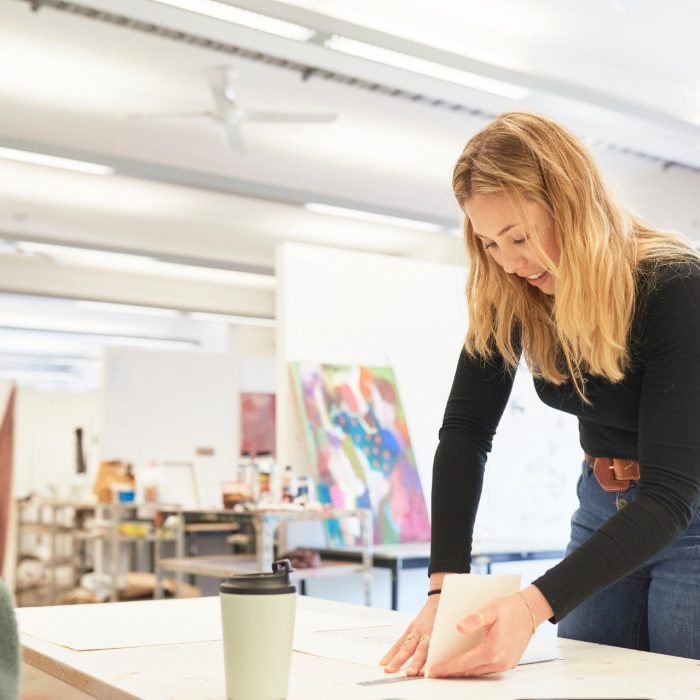Visual arts

What is visual arts?
Visual arts at UNSW is designed for students wanting to explore and develop their art practice in a supportive and engaged artistic community. With a focus on studio-based learning underpinned by specialist workshops and world-class facilities, you’ll be supported to experiment with a range of artistic media, techniques, and processes as you develop your individual contemporary art practice. Push the boundaries through drawing, painting, photography, printmaking, sculpture, moving image, and interdisciplinary artforms, and challenge yourself as you explore the ideas and questions that are important and meaningful to you.
Why study visual arts at UNSW?
Studying Visual Arts allows you to join a creative community with an unmatched record for producing critically acclaimed artists, designers, and creators. Our graduates are exhibited and collected widely in Australia and internationally, including in many of the world’s leading museums, galleries and major biennales. Our graduates consistently achieve national recognition - winning Australia’s most prestigious art prizes, including the Archibald and Blake prizes, the NSW Visual Arts Emerging Fellowship, as well as other notable prizes, scholarships and residencies.
Become a part of an active and peer-oriented studio environment where you’ll receive regular focused feedback on your art practice and contribute to critical discussions about art and its wider impacts. This includes a range of historical, cultural, social, political, and theoretical contexts. Professional practice skills and pathways are also embedded throughout, giving you the means to chart your future as an artist and creative professional.
Develop and combine practical skills across multiple studio areas as you acquire the creative, conceptual, and professional skills for your independent artistic practice.
-
In the drawing studio, you’ll develop understandings of the formal, material and conceptual possibilities of contemporary drawing practice. You’ll work from the human figure, experiment with a range of traditional and contemporary materials and extend your individual practice through rigorous creative and experimental approaches.
-
In the painting studio, you’ll engage with painting as a formal, material and conceptual practice. Exploring connections between conceptual and material enquiry, you’ll develop an individual practice by testing ideas and techniques in a critically-informed studio environment.
-
In the printmaking studio, you’ll acquire diverse technical skills in traditional and contemporary print methods, including digital imaging, etching, lithography, relief printing and screen-printing. You’ll use collaborative enquiry, analysis, critique and reflection to generate ideas and artworks in a contemporary printmaking environment.
-
In the photography studio, you’ll develop diverse and transferable photographic skills, supporting you to become artists and practitioners in a variety of fields. The studio fosters critical enquiry and experimentation to explore the material and conceptual possibilities of photography in contemporary contexts.
-
In the sculpture studio, you’ll develop artworks by engaging with sculptural, spatial and social possibilities of contemporary art. The studio fosters a collaborative and critically-informed approach to support students in developing their artistic practice.
-
In the moving image studio, you’ll explore contemporary approaches to video art, short film, audio-visual composition and installation. You’ll develop understandings and skills in a variety of creative contexts for moving image practice, including gallery, screen, virtual and public spaces.
Through a series of core studio art practice courses, you’ll also be supported to explore a breadth of understanding of fine arts practice while you dive deep and develop your independent practice.
Careers in visual arts
A degree in visual arts will give you transferable skills across a diverse range of industries. On top of this, you will graduate with the confidence and insights to kick-start your career and thrive in the creative and cultural industries. Our graduates move into diverse spaces, including:
- Artist, painter, sculptor, photographer, printmaker, drawer, video artist, installation artist, performance artist, interdisciplinary artist
- Art direction, advertising and communications
- Arts and cultural administration and policymaking
- Arts education and training
- Arts writing, publishing and criticism
- Commercial photography and photojournalism
- Contemporary art practice
- Curating and program management in festivals, museums, galleries and public spaces
- Exhibition planning, design and installation
- Entertainment, media and technology industries
- Theatre, film and television production
- Urban planning, site activation and public art
Study
-
We offer the below undergraduate courses with a specialisation in visual arts:
- Bachelor of Fine Arts
- Bachelor of Advanced Science (Honours ) / Fine Arts
- Bachelor of Commerce / Fine Arts
- Bachelor of Computer Science / Fine Arts
- Bachelor of Fine Arts / Arts
- Bachelor of Fine Arts / Education (Secondary)
- Bachelor of Fine Arts / Engineering (Honours)
- Bachelor of Fine Arts / Media
- Bachelor of Fine Arts / Law
- Bachelor of Science / Fine Arts
In addition to the above courses, we offer the below undergraduate single degrees with a minor in visual arts:
- Bachelor of Arts
- Bachelor of Design
- Bachelor of Fine Arts
- Bachelor of Media
- Bachelor of Social Sciences
-
Honours is an extra year of study that offers you a chance to develop your research and professional skills guided by staff who are passionate about research and the development of new researchers.
-
You can develop further expertise in visual arts through the following postgraduate programs
-
Through a Master of Fine Arts, you’ll undertake supervised research and investigation into an approved area of fine arts, media arts, design, or curatorial practice through a substantial body of creative practice and a 15,000 – 20,000 word dissertation. Find out more.
Postgraduate research through a PhD or Master of Philosophy (MPhil) will deepen your expertise and help you develop a broad intellectual sophistication, research, and professional skills that are prized by employers. You’ll have access to first-rate facilities and world-class supervisors at the forefront of their fields in fine arts. Find out more.
